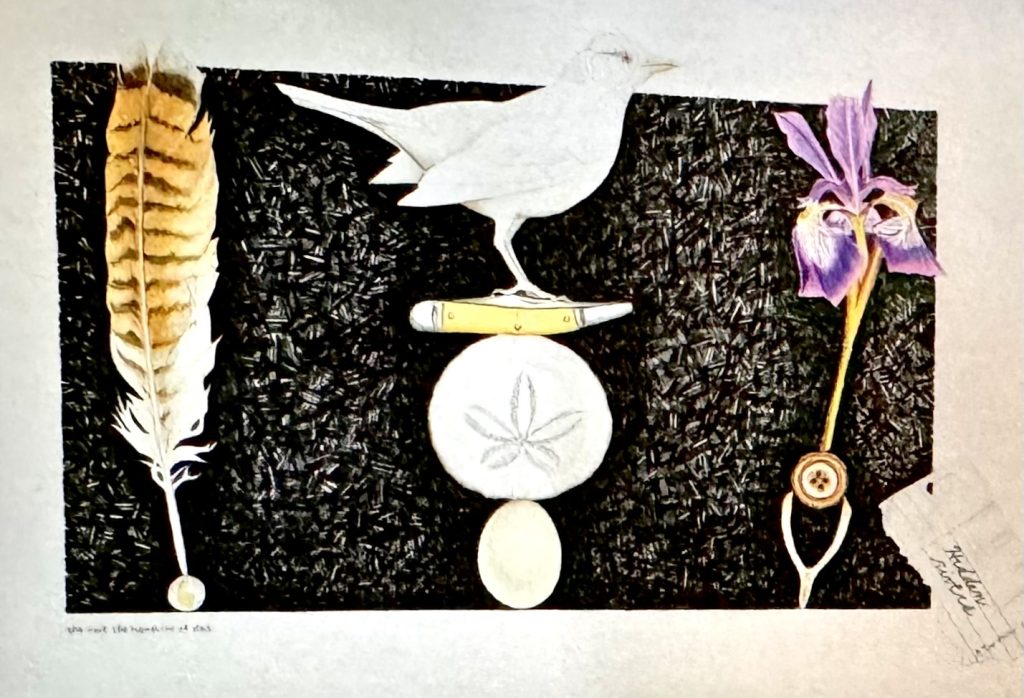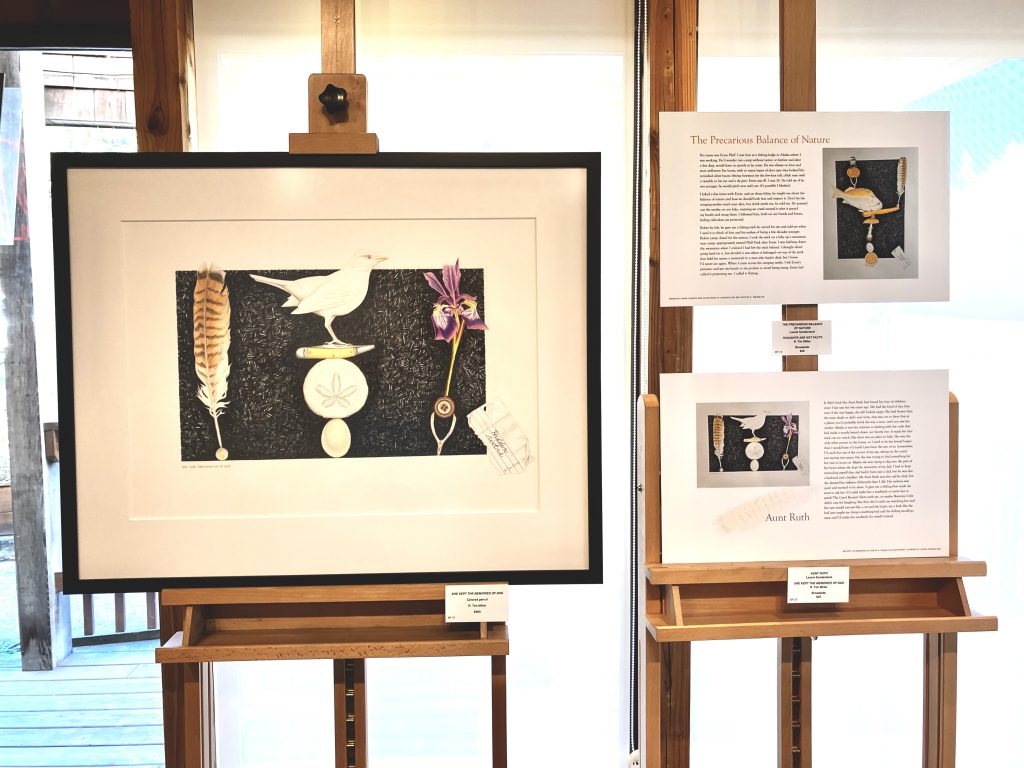
Hoffman Center for the Arts, Manzanita, Oregon
To readers:
This post is confusing. Art responding to art with art, but bear with me. Last spring, I submitted three, 350 word essays for a competition and they were selected to be a part of the Hoffman Arts Center’s Word & Image in Manzanita, Oregon. I was randomly paired with an artist whose three works were also chosen. I responded to one of his drawing with my words and he responded to one of my essays with a drawing. The end result results were two drawings and two written pieces that were shown at a reveal in early October in Manzanita, Oregon. I’ve tried to explain this as simply as I can, but even I was getting confused the night of the reveal. Here’s how it went:
With my son, Thomas, as my plus one, my cheerleader and my support, I attended the Word and Image event a few weeks ago in Manzanita, Oregon. This was the wrap up to the event that began last spring when my essays were selected to be a part of the project and a few months later, I was paired with an artist. The artist, Tim Miller, had three of my essays to select one from and respond to with a drawing, and I had three drawings of his to select one to respond to with a 350-word essay. Got it?
After being paired with Tim last June, we chatted for a bit, getting to know each other, then went our separate ways, me back to Boulder and Tim back to his hometown a few miles away. We were emailed each other’s work the following day and Tim immediately texted and told me which essay of mine he had chosen, adding that it was selected on one sentence that he was inspired by. I asked him which essay and he told me, “Aunt Ruth.” I was surprised, but I’m not sure why. “Aunt Ruth” was a passage taken from a fiction novel I wrote (first draft), with a ten year-old protagonist/narrator. (I’m on my third draft of the book now, likely with a few more drafts ahead, but the “Aunt Ruth” passage has survived all cuts). He made his decision quickly. I pondered for a few weeks before deciding which drawing of his I wanted to respond to.
Fast forward a few months and Tim reached out and told me his drawing was completed and did I want to see it. No, Tim Miller, I do not want to see it, I told him. I wanted to be surprised at the reveal on October 5th.
Thomas and I drove to the coast on the 4th, did my favorite hike on the 5th then had an early dinner before the event. I was nervous. I don’t like to speak in front of an audience unless it is a more organic, unplanned situation and I’m given the floor to tell a story in a causal setting. Although I always read my work out loud before sending it out into the world as that’s how I catch mistakes, it’s within the confines of my small office and not in front of an audience. With my plus one son in the audience giving me a nod of “you’ve got this,” I took the mic and read my words while Tim’s drawing was projected on the wall next to me. Once I started reading, I found my confidence and it felt good to be able to read my words, inspired by the artwork projected on the wall.
I’m doing no favor to Tim’s drawings by posting them this way, as they are drawings that beckon the viewer to move closer for the detail. I apologize for the post’s lack of detail. They truly are beautiful drawings.
Tim’s drawing, and the drawing I responded to:
Thoughts are Not Facts

My response:
The Precarious Balance of Nature
His name was Ernie Pfaff. I met him at a fishing lodge in Alaska where I was working. He’d wander into camp without notice or fanfare and, after a few days, would leave as quietly as he came. He was always on foot and wore Pac boots, with so many layers of duct tape they looked like tarnished silver boots — fitting footwear for the five-foot tall, elfish man with a twinkle in his eye and a sly grin. Ernie was 81. I was 26. He told me he would pitch woo with me if he was younger. It’s possible I blushed.
I hiked a few times with Ernie, and on those hikes, he taught me about the balance of nature and how we should both fear and respect it. Don’t let the stinging nettles touch your skin, but drink nettle tea, he told me. He pointed out the nettles on our hike, insisting we crawl around it after it grazed my hands and stung them. I followed him, both on our hands and knees, feeling ridiculous yet protected.
Before he left, he gave me a hiking stick he carved for me and told me when I used it to think of him and his wishes to be a few decades younger. Before camp closed for the season, I took the stick on a hike up a mountain near camp, appropriately named Pfaff Peak after Ernie. Halfway down the mountain, I realized I had left the stick behind. I thought about going back for it but decided it was where it belonged—on top of the peak that held his name, a memorial to a man who hadn’t died, but I knew I’d never see it again. When I came across the stinging nettle, I felt Ernie’s presence and put my hands in my pockets to avoid being stung. Ernie had called it protecting me. I called it flirting.
My essay, that Tim chose to respond to (the line specifically that inspired him I’ve put in bold print)
Aunt Ruth
It didn’t look like Aunt Ruth had found her love of children since I last saw her two years ago. She had the kind of face that even if she was happy, she still looked angry. She had brown hair, the same shade as dad’s and mine, that was cut so short that at a glance, you’d probably think she was a man until you saw her clothes. Maybe it was her solution to dealing with the curls that had made a sturdy branch down our family tree. It made her face stick out too much like there was no place to hide. She was the only other person in the house, so I tried to be her friend longer than I would have if it hadn’t just been the two of us. Sometimes, I’d catch her out of the corner of my eye, sitting on the couch just staring into space, like she was trying to find something for her eyes to focus on. Maybe she was trying to dig into the part of her brain where she kept the memories of my dad. I had to keep reminding myself that Dad wasn’t just a dad but also a husband and a brother. My Aunt Ruth was also sad he died, but she showed her sadness differently than I did. Her sadness was quiet, and wanted to be alone. It gave me a feeling that made me want to ask her if I could make her a sandwich or invite her to watch The Carol Burnett Show with me or maybe Bonanza if she didn’t care for laughing. But then she’d catch me watching her, and her eyes would narrow like a cat, and she’d give me a look like she had just caught me doing something bad, and the feeling would go away, and I’d make the sandwich for myself instead.
Tim’s visual response to “Aunt Ruth“
She Kept the Memories of Dad


And finally, the reveal. Tim’s and my work on display at Hoffman Center for the Arts with the broadsides on the right and Tim’s original work on the left.
Responding to art with art, the Greek term ekphrasis, was an interesting and creative experience for me. It was an honor to be a part of an event with ten talented artists and writers and to have my work share space with theirs. As exciting as it was to be recognized as a writer that evening, having Thomas, as my plus-one, was the highlight for me. I couldn’t help but think of the many times I was in the audience, in the bleachers, or on the sidelines, mouthing the same words to him, “You’ve got this.”
